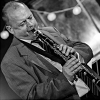
From time to time, I post on albums that showcase saxophone sections. What can I say, I'm a sucker for reeds. The last time I posted on such an album was in June, when I wrote about Jay Cameron's International Sax Band from 1955 and provided a long list of my favorite sax section albums (go here).
Here's the list thus far...
Woody Herman's Four Brothers band (1947), Gene Roland's Boppers (1949), The Brothers!—Al Cohn, Bill Perkins and Richie Kamuca (1955), Jay Cameron's International Sax Band (1955), Al Cohn and the Sax Section (1956), Zoot Sims Plays Alto, Tenor and Baritone (1956), Zoot Sims Plays Four Altos (1956), Reeds in Hi-Fi—Pete Rugolo (1956), Four Brothers Together Again! (1957), The Gerry Mulligan Song Book (1957), Hymie Schertzer: All the King's Saxophones (1957), Coleman Hawkins Meets the Big Sax Section (1958), Cross Section: Saxophones—Hal McKusick (1958), Saxophones Inc.—Bobby Prince and His Orchestra (1959), Ten Saxophones and Two Basses—Pete Rugolo (1961), Further Definitions—Benny Carter (1961), Pony Poindexter's Pony's Express (1962), Bud Shank and the Sax Section (1966), Dave Pell's Prez Conference (1978), Supersax (1972-1988), Marlene VerPlanck Meets Saxomania (1993), Harry Allen's The Candy Men (2016).
Now let's add another: Barnes/O'Higgins & the Sax Section: Oh Gee! (Woodville). Recorded in London in January 2015, the album features Alan Barnes (as,sop), Sam Mayne (as), Dave O'Higgins and Judith O'Higgins (ts), Karen Sharp (bar), Robin Aspland (p), Adam King (b) and Sebastiaan de Krom (d). This British ensemble takes on Benny Carter's Doozy, The End of a Love Affair, Carter's Just a Mood, The Chase, Alan Barnes's Orejas de Cerdos, Topsy, Chelsea Bridge, Our Delight, Duke Ellington's Ko-ko and Miles Davis's Oh Gee!
The arrangements are by Alan Barnes and David O'Higgins (above), and the reed players are superb, both as a unit and as soloists. The writing is airy, well paced and takes full advantage of the tough, breezy reed players. Behind the reeds, the rhythm section swings hard, providing the right amount of drive.
As Barnes writes in his notes, “We recorded in the old-fashioned way: a run through, then straight to record. What you hear is what happened." Meaning, tracks weren't the result of the best snips from multiple takes. It was recorded in one shot, which means this band rehearsed its tail off before recording.
I'm surprised this album didn't get more play in the States when it was released. It's terrific.
Here's the list thus far...
Woody Herman's Four Brothers band (1947), Gene Roland's Boppers (1949), The Brothers!—Al Cohn, Bill Perkins and Richie Kamuca (1955), Jay Cameron's International Sax Band (1955), Al Cohn and the Sax Section (1956), Zoot Sims Plays Alto, Tenor and Baritone (1956), Zoot Sims Plays Four Altos (1956), Reeds in Hi-Fi—Pete Rugolo (1956), Four Brothers Together Again! (1957), The Gerry Mulligan Song Book (1957), Hymie Schertzer: All the King's Saxophones (1957), Coleman Hawkins Meets the Big Sax Section (1958), Cross Section: Saxophones—Hal McKusick (1958), Saxophones Inc.—Bobby Prince and His Orchestra (1959), Ten Saxophones and Two Basses—Pete Rugolo (1961), Further Definitions—Benny Carter (1961), Pony Poindexter's Pony's Express (1962), Bud Shank and the Sax Section (1966), Dave Pell's Prez Conference (1978), Supersax (1972-1988), Marlene VerPlanck Meets Saxomania (1993), Harry Allen's The Candy Men (2016).
Now let's add another: Barnes/O'Higgins & the Sax Section: Oh Gee! (Woodville). Recorded in London in January 2015, the album features Alan Barnes (as,sop), Sam Mayne (as), Dave O'Higgins and Judith O'Higgins (ts), Karen Sharp (bar), Robin Aspland (p), Adam King (b) and Sebastiaan de Krom (d). This British ensemble takes on Benny Carter's Doozy, The End of a Love Affair, Carter's Just a Mood, The Chase, Alan Barnes's Orejas de Cerdos, Topsy, Chelsea Bridge, Our Delight, Duke Ellington's Ko-ko and Miles Davis's Oh Gee!
The arrangements are by Alan Barnes and David O'Higgins (above), and the reed players are superb, both as a unit and as soloists. The writing is airy, well paced and takes full advantage of the tough, breezy reed players. Behind the reeds, the rhythm section swings hard, providing the right amount of drive.
As Barnes writes in his notes, “We recorded in the old-fashioned way: a run through, then straight to record. What you hear is what happened." Meaning, tracks weren't the result of the best snips from multiple takes. It was recorded in one shot, which means this band rehearsed its tail off before recording.
I'm surprised this album didn't get more play in the States when it was released. It's terrific.
This story appears courtesy of JazzWax by Marc Myers.
Copyright © 2026. All rights reserved.























